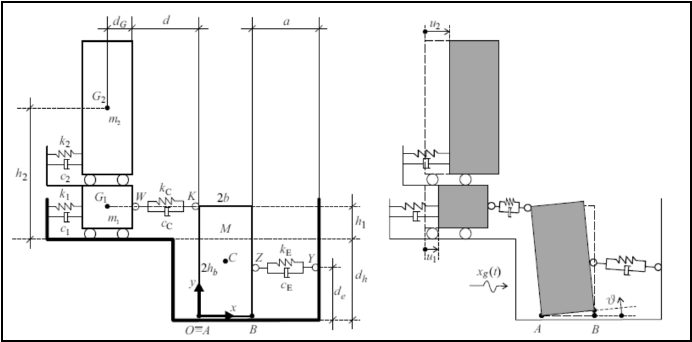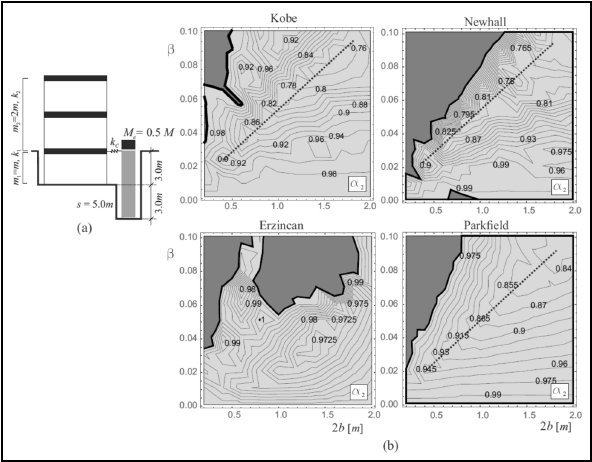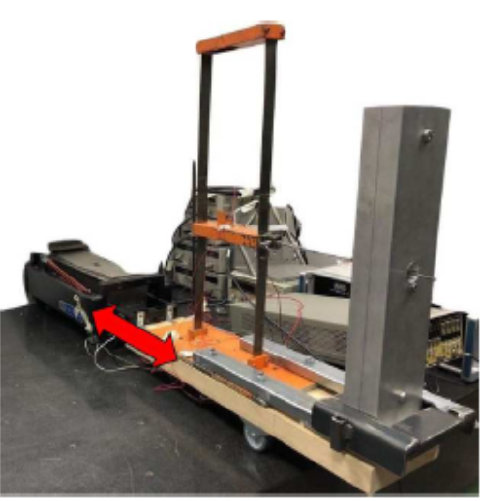UNIVERSITY OF L'AQUILA - ITALY
D.I.C.E.A.A. - Dipartimento di Ingegneria Civile, Edile-Architettura e Ambientale
Structural improve
Structural improvement
Structure+block
Copyright © A.Di Egidio

The present work investigates the use of a rigid rocking block as a tool to reduce vibrations in a frame structure. The study is based
on a simplified model composed by a 2-DOF linear system, meant to represent a general M-DOF frame structure, coupled with a rocking
rigid block through a linear visco-elastic device, which connects only the lower part of the 2-DOF system. The possibility to restrain
the block directly to the ground, by means of a second visco-elastic device, is investigated as well. The dynamic response of the
model under an harmonic base excitation is then analysed in order to evaluate the effectiveness of the coupling in reducing the displacements
and the drift of the 2-DOF system. The non-linear equations of motion of the coupled assemblage 2-DOF-block are obtained by a Lagrangian
approach and then numerically integrated considering some reference mechanical and geometrical quantities as variable parameters.
It follows an extensive parametric analysis, whose results are summarized through behaviour maps, which portray the ratio between
the maximum displacements and drifts of the system, with and without the coupling with the rigid block, for several combinations of
system’s parameters. When the ratio of the displacements is less than unity, the coupling is considered effective. Results show that
the presence of the rocking rigid block improves the dynamics of the system in large ranges of the characterizing parameters
Fig. 10.3: Coupled mecjanical system


This paper investigates the possibility to enhance the seismic response of a frame structure by the combined use of an external rocking
wall and some inerters attached to the frame and to the wall as well. This innovative mechanical assemblage is here introduced by
means of a reduced order 3-\textit{DOF} model. This latter is constituted by a two-degree of freedom linear system, used as a model
for a multi-story frame structure, and by a rigid block, which represents the rocking wall. The frame-wall connection is represented
by an elastic link spanning from the top of the block to the first story of the frame structure. Such a mechanical system, already
studied by the Authors in other papers, is here enriched by the introduction of some inerters attached to both the frame and the block,
in order to have some apparent inertia forces. For this model, the nonlinear equations of motion are obtained and successively numerically
integrated, considering seismic base motions. An extensive parametric analysis is performed and the results are summarized in gain
maps that show the ratio of the maximum displacements or drifts of the coupled and uncoupled systems, thus providing a measure of
the seismic enhancements deriving from the coupling. It is found that there are wide regions of the adopted base parameters where
coupling is effective. Results also show that the use of inerters increases the effectiveness of the coupling with the block, thus
allowing to use of smaller blocks. Finally, the proposed procedure based on spectrum compatibility criterion appears able to provide
a useful preliminary design tool to choose the main characteristics of the system.
Fig. 10.4. Parametric analysis: (a) Three-storey coupling scheme with added mass; (b) gain maps.
In this paper the linear elastic coupling between a 2 degree of freedom shear-type frame system and a rigid block is analytically
and experimentally investigated. As demonstrated by some of the authors in previous papers, it is possible to choose a coupling system
able to guarantee advantages, whatever the mechanical characteristics of the frame. The main purpose of the investigation is to validate
the analytical model. The nonlinear equations of motion of the coupled system are obtained by a Lagrangian approach and successively
numerically integrated under harmonic and seismic excitation. The results, in terms of gain graphs, maps and spectra, represent
the ratio between the maximum displacements or drifts of the coupled and uncoupled systems as a function of the system's parameters.
Numerical investigations show the effectiveness of the nonlinear coupling for a large set of parameters. Thus experimental tests are
carried out to verify the analytical results. An electro-dynamic long-stroke shaker sinusoidally and seismically forces a shear-type
2 d.o.f frame coupled with a rigid aluminium block. The experimental investigations confirm the effectiveness of the coupling as predicted
by the analytical model.
Fig. 10.5. Experimental setup.





















